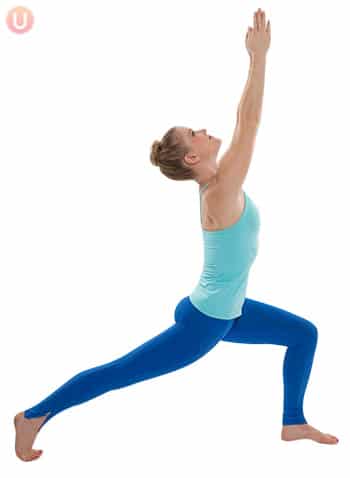This post contains affiliate links. Please see our disclosure policy.

A crescent lunge is a yoga pose that provides a deep stretch for the hip flexors, groin and legs and opens the front of the body including chest and shoulders. If you learn how to do crescent lunges, you will also strengthen and tone your thighs, hips and butt, while practicing balance and stability.
Lunge poses in a yoga practice are often repeated many times. When you read the list of benefits you can likely see why. Much of what people search out in yoga is accomplished in this one pose.
Hip pain and tightness tops the list of complaints when it comes to tight areas on the body.
Stretching the hip flexors doesn’t come easy and there are not as many poses available for this as there are for something like tight hamstrings. Crescent lunges undoubtedly stretch the hip flexors.

Save This Article To Read Later
Crescent Lunge Pose Instructions
Here are the steps to performing Crescent Lunge on Knee:
- From a standing position, step the ball of your left foot to the back of the mat. Keep your feet slightly wider than one another like standing on railroad tracks.
- Reach both arms straight overhead and bend the right knee to 90 degrees.
- Relax your shoulders as you continue reaching up and lengthen the back leg. Hold 30 seconds and switch sides.
As you open yourself up into the crescent lunge, make sure to tuck your tailbone and gently press the hips forward while reaching the arms over the back of the head so that the body achieve the shape of a crescent moon.
This is where the name of the pose originated. By reaching as far as you can through your fingertips you not only increase the stretch through the front of the hips, but you add an opening to the chest, abdominals and front of the shoulders.
There are two options for the placing of your back foot. You can keep your toes tucked and on the ground, or you can point the toes and rest the top of the foot onto the floor. Either way, this pose is a remarkable stretch that everyone can enjoy.
Watch below as Chris Freytag demonstrates how to perform a crescent lunge:
What Muscles Does A Crescent Lunge Work?
Crescent lunge is a standing yoga pose that stretches your legs and hips and also strengthens your lower body and core while promoting good posture and spinal alignment.
Benefits of Crescent Lunges
There are many reasons you should incorporate crescent lunge into your workouts. Here are just a few:
Stronger Legs
Crescent lunge is a pose that strengthens your thighs, hips and butt while also working your stabilizers to keep you balanced and aligned. This is an isometric exercise, meaning your hold still. However, even though you don’t move, you can feel your muscles engage and work to get stronger.
Stretches Legs and Hips
Crescent lunge stretches the muscles in your legs, groin, and hips flexors. Those who struggle with sciatica or tight lower backs are given crescent lunge as one way to help relieve the tightness and lessen the pain. On the other hand, it is a great way to prevent such issues so should be used frequently to keep your body moving freely and without pain.
Opens the Front of the Body
Crescent lunge is an excellent way to open the front of the torso, chest and shoulders.
How Many Calories Does a Crescent Lunge Burn?
People often ask how many calories they are burning in their workouts. Most exercises will generally burn about 100 calories for every 10 minutes you are working at higher intensity. Bottom line – the harder you work, the more calories you burn. The benefits of crescent lunges are not really reflected in the calorie burn, however, a good yoga practice can be a great way to include crescent lunge and still burn the calories desired. So get your yoga on!
Other Exercises Similar to Crescent Lunge
If you like crescent lunges and the results you get from them, here are a few more exercises you might want to try.


